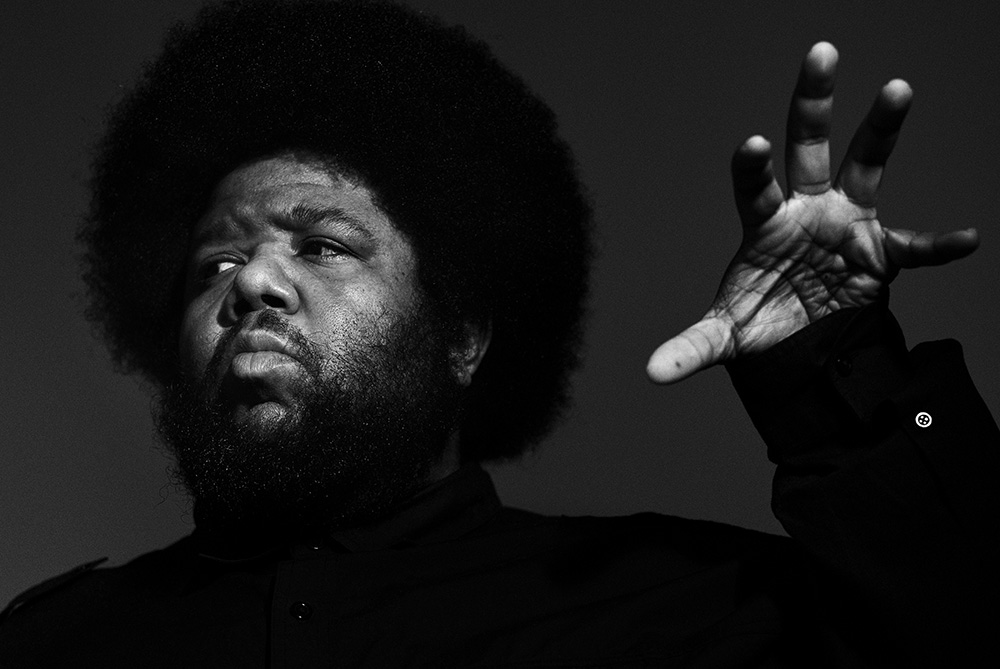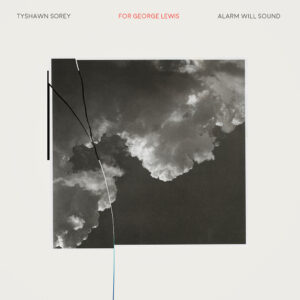Tyshawn Sorey is a remarkable figure in contemporary music. For the past twenty years, he has been among the most highly regarded and in-demand drummers in avant-garde jazz, playing with major contemporary figures such as Steve Coleman, Kris Davis, Vijay Iyer, and Steve Lehman, as well as veterans like Marilyn Crispell, Myra Melford, Roscoe Mitchell, and John Zorn. On albums like Alloy, The Inner Spectrum of Variables, and Verisimilitude—the trilogy of trio records he released between 2014 and 2017—he blurs the boundaries between jazz and classical music, exploring sound textures and patches of silence as well as driving rhythms. Over the same period, Sorey, who won a MacArthur Fellowship in 2017 and teaches at the University of Pennsylvania, has been developing his oeuvre as a classical composer.
Until recently, you would have had to visit a concert hall to hear most of Sorey’s major classical works. His new double album For George Lewis | Autoschediasms, a collaboration with the contemporary classical ensemble Alarm Will Sound, is the first extended recording of Sorey’s compositions played exclusively by classical musicians and released outside the jazz context. It should introduce many more listeners to Sorey the composer. “For George Lewis,” a single work almost an hour long, is dedicated to the genre-bending composer who was Sorey’s mentor. Out of slowly unfolding drones rise gorgeous melodic passages; listening to the whole piece is a transcendent experience. The second disc offers two versions of “Autoschediasms,” which draws on a tradition of avant-garde music in which a composer/conductor cues the ensemble with hand signals, flashcards, and other means to create a collage of sound, essentially a spontaneous composition.
Sorey and I spoke over Zoom about the relationship between his composing and drumming, music-making during the pandemic, and his recent projects, including a collaboration with the poet Terrance Hayes and a tribute to the legendary drummer Paul Motian, who died in 2011.
INTERVIEWER
Your achievements in either drumming or composing would be enough to fill a career for most artists. Can you talk about how the two practices fit together for you?
SOREY
They inform each other. Just working with a lot of people who are compositionally minded, whether the music is spontaneous or fully notated, has informed my drumming. Because whenever I’m playing drums, I’m always thinking compositionally about how things develop, taking a longer look at things rather than simply playing drums on top of some form. I want to see the whole picture of what’s going on in the music. Why do certain harmonies accompany the musicians in a particular way? Or why does a type of rhythmic information that I’m hearing in a composition make me accompany the musicians in a certain way?
INTERVIEWER
“For George Lewis” is so much a piece about space and time. Much of your music, even on the early albums, has incorporated a lot of space and silence, and yet your drumming is often just the opposite—on the busier side. Have you always liked music with a lot of silence in it?
SOREY
I feel like a lot of contemporary composition has this tendency to be more maximalist, with a lot of material and a lot of activity. And I feel like, if that’s happening, why am I going to come in and crowd that particular sphere of composers? They’re already doing that really well. I’m not going to come in there and do what they’re doing. I want to do something that is fully engaging and interesting to me. So, I decided to create music that deals with that in the opposite direction.
INTERVIEWER
“Autoschediasms” is a piece that features a good deal of improvisation. You had done the first version on the album with Alarm Will Sound in the studio, but the second one had to be recorded virtually because of the pandemic, right?
SOREY
We wanted to do it again, but performance opportunities were obviously being canceled. Alan Pierson, Alarm Will Sound’s artistic director, one day called me out of the blue and was like, Can we try “Autoschediasms,” but with you doing it virtually over video chat? We figured out a way to make it happen using various programs. This was completely new to me. It proved to be a great challenge that cost a great deal of time and effort—you know, setting up things, making sure that people were properly masked, safety restrictions and all of that. So, you have one group of musicians who are in New York City, but they would be in completely different places. One person could be at home. Another group of people could be in a studio booth. Another group of players could be in a big room in a studio or something like that. Everybody was separated in these four or five individualized setups. I’m over here in Philly looking at about sixteen or seventeen screens. When I realized what the setup was going to be like, I had to change my entire game plan of how to do that piece without using batons or using my hands so much because of latency concerns over video chat. So, I came up with a system that involved both color and flashcards as well as new signals that I’ve had to create for the digital “Autoschediasms.” There was a lot of glitching happening. I think two of the screens went blank during the performance, and I couldn’t tell these players what to play or ask these players to do something. But it still worked, and it was fantastic.
INTERVIEWER
You’ve been working with classical players and ensembles for a while. Do you feel like they’re very different from jazz musicians in terms of how they approach playing music?
SOREY
Oh, definitely. I’ve done “Autoschediasms” with a lot of jazz-like players or free improvisers. Those are really rewarding experiences. When I work with classical ensembles, though, it tends to vary. I know with any ensemble with whom I’ve had a very strong rapport, they usually end up being the most successful ones to do it. So, the International Contemporary Ensemble is one. Alarm Will Sound, of course, is another. I’ve done “Autoschediasms” with other classical ensembles—one, for example, that had never improvised. There were some moments that were good, but there were a lot of inconsistencies and a lot of missed opportunities. I guess it’s because the players felt afraid of making mistakes, an attitude that is kind of conditioned in symphony orchestra musicians. It really felt like they were just doing what the conductor told them to do because that’s their conditioning. They don’t understand that it’s a democratic process of music-making that’s involved. I always say that this is a duet between orchestra and conductor. They have to challenge me, and I have to challenge them. Because if you make a mistake, then that challenges me to make it work.
INTERVIEWER
I want to ask you about “Cycles of My Being,” your collaboration with poet Terrance Hayes and operatic tenor Lawrence Brownlee. How did that come together?
SOREY
The three of us only met one time in person in New York, in 2017. We were talking about these killings of unarmed Black men and women. Terrance, at that time, was working on his American Sonnets for My Past and Future Assassin. After that meeting, he sent me an email with some of these sonnets that he’d been working on. It’s all really brilliant, brilliant, brilliant work. Lawrence Brownlee also provided texts for “Cycles of My Being.” What I generally do with any music that involves text is sit with the lyrics before I write music.
INTERVIEWER
What was it like to work with Terrance?
SOREY
He’s just brilliant on every level. The way that he plays with words, these very abstract ways of putting things together—but his work is also very real. It’s almost subliminal, how he deals with words. The way that he approaches form is very, very interesting in terms of the buildup of whatever is going on in the sonnet. Some may have these very interesting formal elements. I’m looking at them like, Wow, I want to do that in music.
INTERVIEWER
The last thing I wanted to ask you about is Paul Motian. I watched the Village Vanguard streamed concert you did with Bill Frisell and Joe Lovano. And I thought, Oh my God, are they doing the Motian trio? He’s one of my favorite drummers and one of my favorite jazz composers. I’m wondering in what way he’s important to you, and what the plans are for that project.
SOREY
There will be a record coming next year. Paul Motian is another major force of influence for me, both as a composer and as a drummer. We talked earlier about space. Well, Paul Motian was kind of an expert at that—being able to leave a lot of space and allow things to happen. And when he allowed things to happen, it made him push the music even more in interesting directions. The other thing was his touch.
He’s pulling sound out of the instrument rather than playing at the drum set. He was pulling sound out of the drums by his touch, the attack, the dynamics. He’s a very dynamic drummer. That has inspired me since I began performing music with ensembles in the late nineties. From a compositional standpoint, too, he has a very oblique sense—and I don’t mean oblique in a negative way—of melody and harmony. A lot of notes that he would write melodically would end up in unexpected places. But they’d make sense, somehow. The musicians he had around him—like Joe and Bill, for example—could do so much with one very short, simple phrase that Paul Motian wrote. And he was my type of person. He was always very crass and had a very interesting sense of humor.
INTERVIEWER
I saw Motian perform a lot toward the end of his life, and what amazed me was that, as he got older and couldn’t quite play as fast, he used that limitation as a way of adding space to the music. So every hit would have a lot more value.
SOREY
That’s a totally different kind of virtuosity that I strive for in my own playing. Because everybody talks about virtuosity as being about how fast you can play or how loud you can play or how much technique you have available. There’s nothing wrong with having great technique at your disposal, but how you use that technique is what’s going to make the difference. I’m forty-one years old, I can’t play the same way—all fast and crazy—that I was playing when I was nineteen or twenty years old. I don’t have the same touch. My body doesn’t move the same way. So, the real virtuosity comes with how you respond to those changes. Paul was a master at that. As you said, every note that he played meant so much more, had so much more depth to it. There’s a certain kind of richness that comes with this type of virtuosity, where it’s really about listening. So, when I was writing my music for this Paul Motian trio, I wanted to keep that in mind. The virtuosity is not in how fast you can play or how many notes you can play or how technically advanced everything is. It’s really about how we breathe together, how we move together, how we listen, how we experience each other, what it feels like to play as a trio but not sound like three people. The way I’ve always viewed the notion of trio is that trio means one.
Craig Morgan Teicher is the digital director for The Paris Review and the author of several books, including We Begin In Gladness: How Poets Progress and Welcome to Sonnetville, New Jersey.
from The Paris Review https://ift.tt/3uB85PP


Comments
Post a Comment